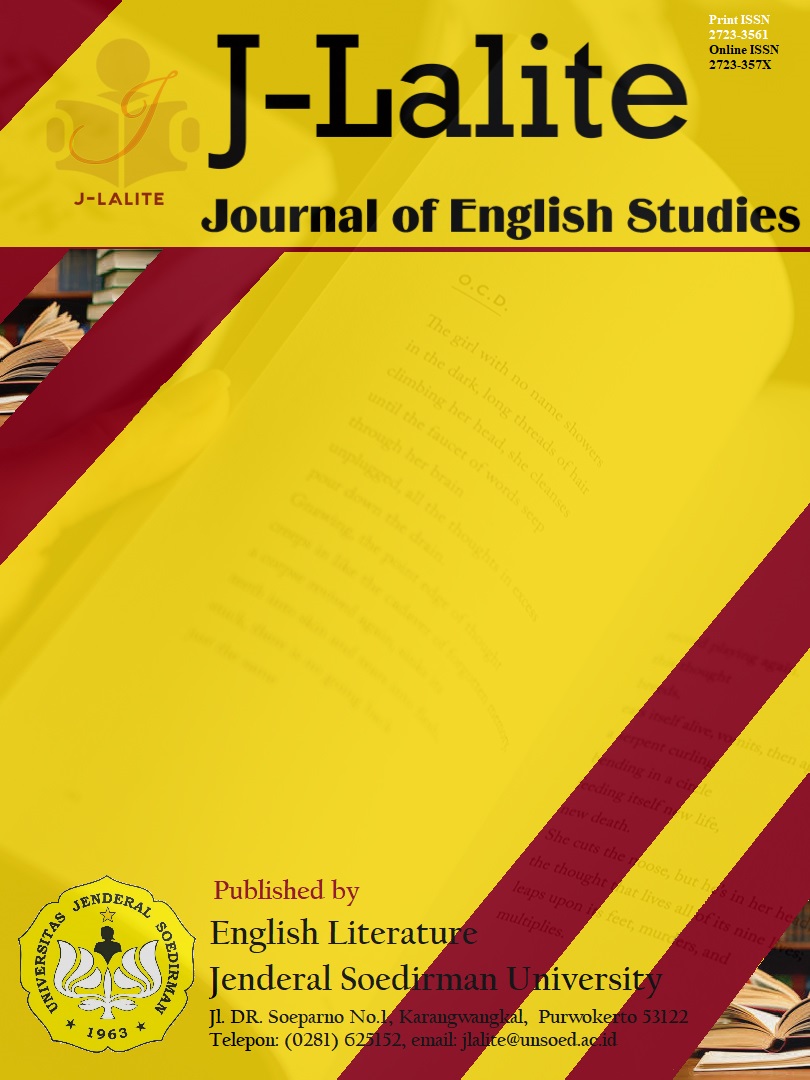Examining Rosalind/Ganymede’s and Viola/Cesario’s Disguised Bodies in Shakespeare’s As You Like It and Twelfth Night
Abstract
In this article, I explore the disguised body in two of Shakespeare’s comedies As You Like It and Twelfth Night. Since the human body can be problematized, it is worth trying to examine Rosalind’s and Viola’s disguised bodies under the lens of Erving Goffman’s dramaturgy theory. This theory examines how people present themselves differently depending on their circumstances. In contextualizing the exploration of the disguised bodies, I employ the script of As You Like It and Twelfth Night as the primary data source. The result shows that both main characters in the plays disguise themselves as men and their disguised bodies symbolize new meanings namely safety and freedom. Rosalind’s and Viola’s symbolic bodies have transformed into agentic bodies from which these bodies enable them to help the men they love. The agentic quality of Rosalind’s and Viola’s bodies lies in their ability to manage, control, and present their bodies by whom they interact.
References
Belsey, C. (2014). Gender in Different Dispensation: The Case of Shakespeare. In DiGeSt. Journal of Diversity and Gender Studies 1(1): pp. 7-19 Leuven University Press. Available at https://www.jstor.org/stable/10.11116/jdivegenstud.1.1.0007
Bryne, M. St. C. 1926. Elizabethan Life in Town and Country. Boston and New York: Houghton Mifflin Company.
Cross-dressing in Shakespeare’s Comedies. n.d. A Handout. Print. Accessed March 12, 2015.
Freeburg, V. O. 1915. Disguise Plots in Elizabethan Drama: A Study in Stage Tradition. New York: Columbia University Press.
Howson, A. 2013. The Body in Society: an Introduction 2nd Edition. USA: Polity Press.
Johnová, Lucie. n.d. Patterns of Crossdressing in Shakespeare’s Comedies. Prague: Charles University. Accessed March 12, 2015.
Kumari, N. 2014. Gender Roles in the Renaissance: Role Playing in Shakespeare’s As You Like it, International Journal of English Language, Literature and Humanities, II: III
Massai, S. (Ed.) 2007. William Shakespeare’s Twelfth Night. New York: Routledge.
Kosut, M. and Moore, L.J. (2010). Introduction: Not Just the Reflexive Reflex: Flesh and Bone in the Social Science. In The Body Reader: Essential Social and Cultural Readings Moore, L.J. and Kosut, M. (eds.). New York: New York University Press.
Perko, A. 2008. Gender Role Reversal in Twelfth Night and The Rover. Available at http://ocw.mit.edu/literature
Shakespeare, W.n.d. As You Like It. Feedbooks e-book.
__________. n.d. Twelfth Night, Collins Edition. Project Gutenberg e-book.
Terry, N.S. n.d. Disguise and Misdirection in Comedic Literature, Houston Teachers Institute. Accessed March 12, 2015.
By submitting the manuscript, the author(s) agreed to these following terms:
(1) The copyright of received articles shall be assigned to J-Lalite: Journal of English Studies as the publisher of the journal. The intended copyright includes the right to publish articles in various forms (including reprint). J-Lalite: Journal of English Studies maintain the publishing rights to the published articles.
(2) Author(s) are permitted to disseminate published articles by sharing the link/DOI of the article at J-Lalite: Journal of English Studies. Author(s) are allowed to use their articles for any legal purposes deemed necessary without written permission from J-Lalite: Journal of English Studies with an acknowledgement of initial publication to this journal.
(3) Authors should sign a copyright transfer agreement when they have approved the final proofs sent by J-Lalite: Journal of English Studies prior to the publication.
(4) User/public use of this website will be licensed to Creative Commons Attribution-ShareALike 4.0 International (CC BY-SA 4.0) License.









.png)
.png)
.png)
.png)




